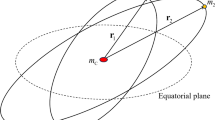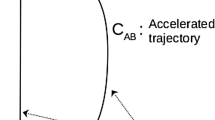Abstract
We numerically investigate the orbital dynamics of a spacecraft, or a comet, or an asteroid in the Pluto-Charon system in a scattering region around Charon using the planar circular restricted three-body problem. The test particle can move in bounded orbits around Charon or escape through the necks around the Lagrangian points \(L_{1}\) and \(L_{2}\) or even collide with the surface of Charon. We explore four of the five possible Hill’s regions configurations depending on the value of the Jacobi constant which is of course related with the total orbital energy. We conduct a thorough numerical analysis on the phase space mixing by classifying initial conditions of orbits and distinguishing between three types of motion: (i) bounded, (ii) escaping and (iii) collisional. In particular, we locate the different basins and we relate them with the corresponding spatial distributions of the escape and collision times. Our results reveal the high complexity of this planetary system. Furthermore, the numerical analysis shows a strong dependence of the properties of the considered basins with the total orbital energy, with a remarkable presence of fractal basin boundaries along all the regimes. Our results are compared with earlier ones regarding the Saturn-Titan planetary system.










Similar content being viewed by others
Notes
The set of initial conditions of orbits which lead to a certain final state (escape, collision or bounded motion) is defined as a basin.
Obviously if we numerically integrate these initial conditions we will see that they lead to immediate collision to Charon.
It should be emphasized that when we state that an area is fractal we simply mean that it has a fractal-like geometry without conducting any specific calculations as in Aguirre et al. (2009).
References
Aguirre, J., Viana, R.L., Sanjuán, M.A.F.: Fractal structures in nonlinear dynamics. Rev. Mod. Phys. 81, 333–386 (2009)
Barrio, R., Blesa, F., Serrano, S.: Fractal structures in the Hénon-Heiles Hamiltonian. Europhys. Lett. 82, 10003 (2008)
Darriba, L.A., Maffione, N.P., Cincotta, P.M., Giordano, C.M.: Comparative study of variational chaos indicators and ODEs’ numerical integrators. International Journal of Bifurcation and Chaos 22, 1230033 (2012)
Canup, R.M.: A giant impact origin of Pluto-Charon. Science 307, 546–550 (2005)
Christy, J.W., Harrington, R.S.: The satellite of Pluto. Astron. J 83, 1005–1008 (1978)
de Assis, S.C., Terra, M.O.: Escape dynamics and fractal basin boundaries in the planar Earth-Moon system. Celest. Mech. Dyn. Astron. 120, 105–130 (2014)
Gómez, G., Llibre, J., Martínez, R., Simó, C.: Dynamics and Mission Design Near Libration Points, Volume I: Fundamentals: The Case of Collinear Libration Points. World Scientific, Singapore (2001a)
Gómez, G., Simó, C., Llibre, J., Mart´nez, R.: Dynamics and Mission Design Near Libration Points, Volume II: Fundamentals: The Case of Triangular Libration Points. World Scientific, Singapore (2001b)
Gómez, G., Jorba, A., Simó, C., Masdemont, J.: Dynamics and Mission Design Near Libration Points, Volume III: Advanced Methods for Collinear Points. World Scientific, Singapore (2001c)
Gómez, G., Jorba, A., Simó, C., Masdemont, J.: Dynamics and Mission Design Near Libration Points, Volume IV: Advanced Methods for Triangular Points. World Scientific, Singapore (2001d)
Gómez, G., Koon, W., Lo, M., Marsden, J., Masdemont, J., Ross, S.: Connecting orbits and invariant manifolds in the spatial restricted three-body problem. Nonlinearity 17, 1571–1606 (2004)
Hénon, M.: Numerical exploration of the restricted problem. V. Astron. Astrophys. 1, 223–238 (1969)
Koon, W.S., Lo, M.W., Marsden, J.E., Ross, S.D.: Heteroclinic connections between periodic orbits and resonance transitions in celestial mechanics. Chaos 10, 427–470 (2000)
Li, W., Huang, H., Peng, F.: Trajectory classification in circular restricted three-body problem using support vector machine. Advances in Space Research 56, 273–280 (2015)
Nagler, J.: Crash test for the Copenhagen problem. Phys. Rev. E 69, 066218 (2004)
Nagler, J.: Crash test for the restricted three-body problem. Phys. Rev. E 71, 026227 (2005)
NASA Space Science Data Coordinated Archive (2015). http://nssdc.gsfc.nasa.gov/
Null, G.W., Owen, W.M., Synnott, S.P.: Masses and densities of Pluto and Charon. Astron. J. 105, 2319–2335 (1993)
Press, H.P., Teukolsky, S.A., Vetterling, W.T., Flannery, B.P.: Numerical Recipes in FORTRAN 77, 2nd edn. Cambridge University Press, Cambridge (1992)
Richardson, A.S., Finn, J.M.: Symplectic integrators with adaptive time steps. Plasma Phys. Control. Fusion 54, 014004 (2012)
Showalter, M.R., Hamilton, D.P.: Resonant interactions and chaotic rotation of Pluto’s small moons. Nature 522, 45–49 (2015)
Simó, C., Stuchi, T.: Central stable/unstable manifolds and the destruction of KAM tori in the planar Hill problem. Physica D 140, 1–32 (2000)
Stern, S.A., Spencer, J., Horizons, N.: The first reconnaissance mission to bodies in the Kuiper belt. Earth Moon and Planets 92, 477–482 (2003)
Stern, S.A., Weaver, H.A., Steffl, A.J., et al.: A giant impact origin for Pluto’s small moons and satellite multiplicity in the Kuiper belt. Nature 439, 946–948 (2006)
Stern, S.A., Mutchler, M.J., Weaver, H.A., Steffl, A.J.: The positions, colors, and photometric variability of Pluto’s small satellites from HST observations: 2005–2006. In: Lunar and Planetary. Institute Science Conference Abstracts, vol. 38, p. 1722 (2007)
Stuchi, T.J., Yokohama, A.A., et al.: Dynamics of a spacecraft and normalization around Lagrangian points in the Neptune-Triton system. Adv. Space Res. 42, 1715–1722 (2008)
Szebehely, V.: Theory of Orbits. Academic Press, New York (1967)
Weaver, H.A., Stern, S.A., Mutchler, M.J., et al.: S/2005 P 1 and S/2005 P 2. IAU Circ. 8625, 1 (2005)
Weaver, H.A., Stern, S.A., Mutchler, M.J., et al.: Discovery of two new satellites of Pluto. Nature 439, 943–945 (2006)
Weaver, H.A., Gibson, W.C., Tapley, M.B., Young, L.A., Stern, S.A.: Overview of the new horizons science payload. Tech. Rep., Johns Hopkins University Applied Physics Laboratory (2007)
Young, L.A., Olkin, C.B., Elliot, J.L., Tholen, D.J., Buie, M.W.: The Charon-Pluto mass ratio from MKO astrometry. Icarus 108, 186–199 (1994)
Zotos, E.E.: Crash test for the Copenhagen problem with oblateness. Celest. Mech. Dyn. Astron. 122, 75–99 (2015a)
Zotos, E.E.: Orbital dynamics in the planar Saturn-Titan system. Astrophys. Space Sci. 358, 4 (2015b). Paper I
Acknowledgements
I would like to express my warmest thanks to the anonymous referee for the careful reading of the manuscript and for all the apt suggestions and comments which allowed us to improve both the quality and the clarity of the paper.
Author information
Authors and Affiliations
Corresponding author
Rights and permissions
About this article
Cite this article
Zotos, E.E. Orbit classification in the planar circular Pluto-Charon system. Astrophys Space Sci 360, 7 (2015). https://doi.org/10.1007/s10509-015-2523-0
Received:
Accepted:
Published:
DOI: https://doi.org/10.1007/s10509-015-2523-0




